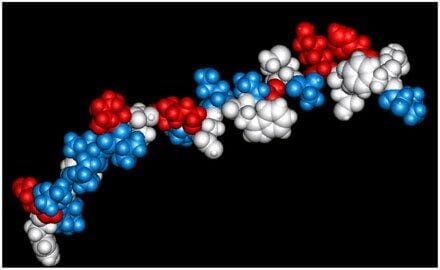New Technique Increases Peptide Lifespan

A new technique developed at the University of the Pacific improves the lifespan of peptides in vivo. With the new method, peptides can reversibly bind a larger blood molecule to avoid being degraded, and at the same time retain their activity. The study, led by Professor Mamoun Alhamadsheh, was published in Nature Chemical Biology and has been featured in Nature Reviews Drug Discovery, a journal that comments on the best papers that appear in high-profile journals.
Peptides are short chains of amino acids linked by amide bonds. The difference between peptides and proteins is arbitrary and generally associated with size: polypeptides under 50 amino acids are not considered proteins, but peptides. They are naturally synthesized, form the different parts of proteins and can carry out biological functions like cellular signaling, hormone regulation, infection response and many others. Peptides have also been chemically synthesized for therapeutic use since the 1950’s. They have been successfully used against cancer or diabetes; due to their small size, they are more selective and safer. The number of peptide-based drugs has increased over the years, and they have a great therapeutic potential, hindered by several challenges. One of them is their fast degradation in vivo. A common strategy to avoid peptides being targeted and degraded is conjugating them to larger blood proteins. Unfortunately, large molecules present steric hindrance: they restrain intermolecular contacts due to their volume and structure. Peptides bound to large molecules can´t access their targets and become ineffective.
A reversible binding to a large molecule allows peptides to disengage from it and act on their target
The authors of the study took a similar approach to increase the half-life of peptides in the bloodstream. They engineered a peptide, an agonist for a GnRH receptor, to bind to the serum protein transthyretin, but reversibly. Their results confirmed that the binding allowed the peptide to avoid the action of serum proteases and glomerular filtration. It increased the half-life of the peptide, while maintaining its affinity for the receptor.
This technique increases in vivo efficacy of therapeutic peptides. With a longer peptide lifespan, patients will not need to be administered the drug so frequently. This will increase the patients quality of life and lower costs.
Source: University of the Pacific
